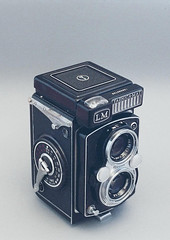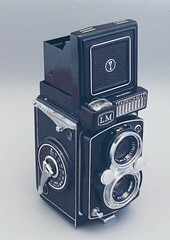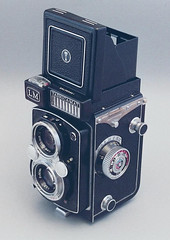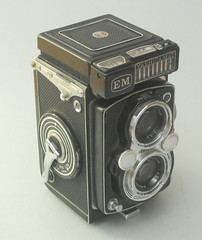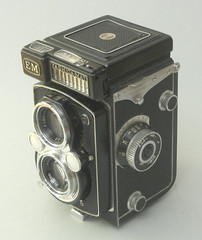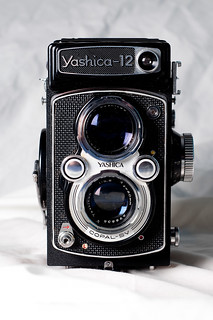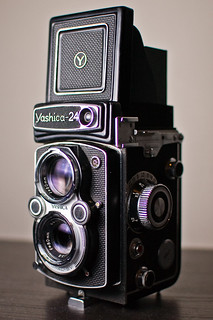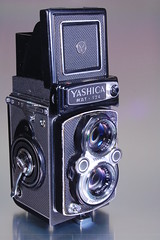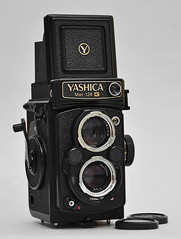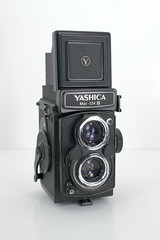Difference between revisions of "Yashica 6×6 TLR (crank advance)"
Rebollo fr (talk | contribs) m (picture layout) |
m (→The Yashica Mat-124 and Mat-124G) |
||
| (108 intermediate revisions by 15 users not shown) | |||
| Line 1: | Line 1: | ||
{{Japanese postwar 6×6 TLR (M–Z) | {{Japanese postwar 6×6 TLR (M–Z) | ||
| − | |image=[http://www.flickr.com/photos/ | + | |image=[http://www.flickr.com/photos/chrizzle/3345446017/in/pool-camerawiki http://farm4.static.flickr.com/3629/3345446017_3aa45e26a1.jpg]<br> by {{image author|Christopher Robin Roberts}} {{with permission}} |
}} | }} | ||
| − | The [[Yashica]] company made a long line of 6×6 [[TLR]] cameras, comprising many models which were the result of a gradual evolution rather than radical change; they are conveniently divided into [[Yashica 6×6 TLR (knob advance)|knob advance models]] and crank advance models. | + | The [[Yashica]] company made a long line of 6×6 [[TLR]] cameras, comprising many models which were the result of a gradual evolution rather than radical change; they are conveniently divided into [[Yashica 6×6 TLR (knob advance)|knob advance models]] and the crank-advance models discussed here. These were branded Yashica '''Mat''' to reflect their auto'''mat'''ic film advance, unlike simpler camera using a [[red window]]. |
== The Yashica-Mat == | == The Yashica-Mat == | ||
| − | The first Yashica TLR with crank advance was the '''Yashica-Mat''', released in 1957. The earliest models are equipped with a 75-mm 3.5 Lumaxar taking lens and a 75-mm 3.2 Lumaxar viewing lens, succeeded by 80-mm lenses with the same specifications. According to some authorities (most notably Mark Hama, who formerly worked in a Yashica factory), the Lumaxar was manufactured for Yashica in West Germany; according to others, it was made in Japan by Tomioka. The lens, a four-element design said to be of the Tessar type, was later re-named Yashinon. The Yashica-Mat | + | The first Yashica TLR with crank advance was the '''Yashica-Mat''', released in 1957. The earliest models are equipped with a 75-mm 3.5 Lumaxar taking lens and a 75-mm 3.2 Lumaxar viewing lens, succeeded by 80-mm lenses with the same specifications. According to some authorities (most notably Mark Hama, who formerly worked in a Yashica factory), the Lumaxar was manufactured for Yashica in West Germany; according to others, it was made in Japan by Tomioka. The lens, a four-element design said to be of the Tessar type, was later re-named Yashinon. The Yashica-Mat used two different shutters the Copal MX or Copal MXV (i.e. with switchable M- or X-synchronisation, and with a self-timer in the latter case). The shutter speeds are marked according to the older system with 1, 1/2, 1/5, 1/10, 1/25, 1/50, 1/100, 1/250 and 1/500. The speed is adjusted with the knurled wheel/knob on the right-hand side (i.e. the user's right) of the lenses. The left-hand wheel adjusts the aperture. As shown in the examples pictured below, the shutter and aperture wheels come in more than one finish. The cable release is of the "Leica nipple" style which is also used on several subsequent models. <!-- up to Y-M 124? --> |
| − | {| | + | |
| − | || | + | {{Flickr_image |
| − | | | + | |image_source= http://www.flickr.com/photos/50699409@N07/4761365147/in/pool-camerawiki |
| − | || | + | |image= http://farm5.staticflickr.com/4082/4761365147_9c624f9040_m.jpg |
| − | |- | + | |image_align= left |
| − | | | + | |image_text= 75mm Lumaxar, Copal MX |
| − | + | |image_by= Gerard Vogels | |
| + | |image_rights= wp | ||
| + | }} | ||
| + | |||
| + | {{Flickr_image | ||
| + | |image_source= http://www.flickr.com/photos/martintaylor/3742232193/in/pool-camerawiki | ||
| + | |image= http://farm4.staticflickr.com/3454/3742232193_05f56a01ca_m.jpg | ||
| + | |image_align= left | ||
| + | |image_text= 80mm Lumaxar (gold insert knob) | ||
| + | |image_by= Martin Taylor | ||
| + | |image_rights= wp | ||
| + | }} | ||
| + | |||
| + | {{Flickr_image | ||
| + | |image_source= http://www.flickr.com/photos/uberj/4439058075/in/pool-camerawiki | ||
| + | |image= http://farm5.static.flickr.com/4003/4439058075_b745e33f38_m.jpg | ||
| + | |image_align= left | ||
| + | |image_text= 80mm Lumaxar (leather insert knob) | ||
| + | |image_by= Jeff Rawdon | ||
| + | |image_rights= with permission | ||
| + | }} | ||
| + | {{Flickr_image | ||
| + | |image_source= http://www.flickr.com/photos/hans_marvell/3658449794/in/pool-camerawiki | ||
| + | |image= http://farm4.static.flickr.com/3307/3658449794_f36e6a1b05_m.jpg | ||
| + | |image_align= left | ||
| + | |image_text= 80mm Yashinon lens (black knob) | ||
| + | |image_by= Hans Marvell | ||
| + | |image_rights= with permission | ||
| + | }} | ||
| + | {{Flickr_image | ||
| + | |image_source= http://www.flickr.com/photos/vagn49/8608471985/in/pool-camerawiki | ||
| + | |image= http://farm9.staticflickr.com/8252/8608471985_e6cced2ed9_m.jpg | ||
| + | |image_align= left | ||
| + | |image_text= 80mm Yashinon lens (silver knob) | ||
| + | |image_by= Vagn Sloth-Madsen | ||
| + | |image_rights= nc | ||
| + | }} | ||
| + | |||
| + | {{br}} | ||
== The Yashica-Mat LM == | == The Yashica-Mat LM == | ||
| − | |||
| − | |||
| − | |||
| − | |||
The '''Yashica-Mat LM''' was introduced in 1958. "LM" stands for [[Light meter|Light Meter]], referring to the uncoupled [[selenium meter|selenium cell exposure meter]] in front of the [[viewfinder]]. It's an all-mechanical camera; even the light meter doesn't need a battery. The Yashica-Mat LM is a solidly made, easy-to-use camera. | The '''Yashica-Mat LM''' was introduced in 1958. "LM" stands for [[Light meter|Light Meter]], referring to the uncoupled [[selenium meter|selenium cell exposure meter]] in front of the [[viewfinder]]. It's an all-mechanical camera; even the light meter doesn't need a battery. The Yashica-Mat LM is a solidly made, easy-to-use camera. | ||
| − | + | ||
| − | + | {|class=plainlinks align=center | |
| − | + | ||{{Flickr_image | |
| − | + | |image_source= http://www.flickr.com/photos/50678983@N00/133076421/in/pool-camerawiki/ | |
| − | </ | + | |image= http://static.flickr.com/47/133076420_8f9008043f_m.jpg |
| + | |image_align= | ||
| + | |image_text= | ||
| + | |image_by= | ||
| + | |image_rights= | ||
| + | }} | ||
| + | || | ||
| + | {{Flickr_image | ||
| + | |image_source= http://www.flickr.com/photos/50678983@N00/133076421/in/pool-camerawiki/ | ||
| + | |image= http://static.flickr.com/53/133076421_77cb1922b7_m.jpg | ||
| + | |image_align= | ||
| + | |image_text= | ||
| + | |image_by= | ||
| + | |image_rights= | ||
| + | }} | ||
| + | || | ||
| + | {{Flickr_image | ||
| + | |image_source= http://www.flickr.com/photos/50678983@N00/133076422/in/pool-camerawiki/ | ||
| + | |image= http://static.flickr.com/45/133076422_407378e7b6_m.jpg | ||
| + | |image_align= | ||
| + | |image_text= | ||
| + | |image_by= | ||
| + | |image_rights= | ||
| + | }} | ||
| + | |- | ||
| + | |colspan=3 align="center"|Yashicamat LM. <BR><small>Images by {{image author|Dries van den Elzen}}.</small> {{with permission}} | ||
| + | |} | ||
=== Features === | === Features === | ||
| − | + | {{Flickr_image | |
| − | + | |image_source= http://www.flickr.com/photos/50678983@N00/133095766/in/pool-camerawiki | |
| − | + | |image= http://farm1.static.flickr.com/52/133095766_3f56ab9409_m.jpg | |
| − | It has a [[Copal]] central shutter with speeds from 1s to 1/500 and B. It offers [[flash sync]] at all speeds. The taking lens is a 3,5 Yashinon, an 80 mm four-element lens said to be of the Tessar design. It can be stopped down to F/22. The viewing lens is a 3,2 Yashinon. It accepts [[bay I]] filters. | + | |image_align= left |
| + | |image_text= | ||
| + | |image_by= Dries van den Elzen | ||
| + | |image_rights= with permission | ||
| + | }} | ||
| + | |||
| + | It has a [[Copal]] MXV central shutter with speeds from 1s to 1/500 and B. It offers [[flash sync]] at all speeds. The taking lens is a 3,5 Yashinon, an 80 mm four-element lens said to be of the Tessar design. It can be stopped down to F/22. The viewing lens is a 3,2 Yashinon. It accepts [[bay I]] filters. As in the earlier camera, the shutter speeds and [[diaphragm]] are set by two wheels on the front plate, and the values set are shown in a window above the viewing lens. Looking onto the ground glass in the waist-level finder, both values and light meter indications are visible. | ||
| + | |||
| + | {{Flickr_image | ||
| + | |image_source= http://www.flickr.com/photos/50678983@N00/133340309/in/pool-camerawiki/ | ||
| + | |image= http://static.flickr.com/46/133340309_6d448fbe8e_m.jpg | ||
| + | |image_align= right | ||
| + | |image_text= | ||
| + | |image_by= Dries van den Elzen | ||
| + | |image_rights= with permission | ||
| + | }} | ||
| − | |||
<br style="clear:left;" /> | <br style="clear:left;" /> | ||
Focusing is done by a focusing wheel on the left of the camera. It has a distance scale surrounded by a [[depth of field]] scale engraved in the body. | Focusing is done by a focusing wheel on the left of the camera. It has a distance scale surrounded by a [[depth of field]] scale engraved in the body. | ||
There is a small window in which you can set the [[film speed|ISO value]] of the film you use and scales for LV, shutter speeds and diaphragms. | There is a small window in which you can set the [[film speed|ISO value]] of the film you use and scales for LV, shutter speeds and diaphragms. | ||
| − | + | ||
| + | {{Flickr_image | ||
| + | |image_source= http://www.flickr.com/photos/50678983@N00/133088797/in/pool-camerawiki/ | ||
| + | |image= http://static.flickr.com/49/133088797_741cbf98a7_m.jpg | ||
| + | |image_align= left | ||
| + | |image_text= | ||
| + | |image_by= Dries van den Elzen | ||
| + | |image_rights= with permission | ||
| + | }} | ||
| + | |||
<br style="clear:right;" /> | <br style="clear:right;" /> | ||
The body is all-metal, covered by black leather. It is quite a heavy camera, about 1.2 Kg. Film transport and cocking the shutter is done by a crank. Winding makes a rattling noise. | The body is all-metal, covered by black leather. It is quite a heavy camera, about 1.2 Kg. Film transport and cocking the shutter is done by a crank. Winding makes a rattling noise. | ||
| Line 47: | Line 130: | ||
== The Yashica-Mat EM == | == The Yashica-Mat EM == | ||
| − | <div class="plainlinks floatright"> | + | <div class="plainlinks floatright"> |
| + | {{Flickr_image | ||
| + | |image_source= http://www.flickr.com/photos/50678983@N00/273337816/in/pool-camerawiki/ | ||
| + | |image= http://static.flickr.com/83/273337816_05a105729c_m.jpg | ||
| + | |image_align= right | ||
| + | |image_text= | ||
| + | |image_by= Dries van den Elzen | ||
| + | |image_rights= with permission | ||
| + | }} | ||
| + | </div> | ||
Released in 1964, the '''Yashica-Mat EM''' features an uncoupled [[light meter]] and an 80mm f/3.5 Yashinon shooting lens. The "EM" stands for Exposure Meter, referring to the [[selenium meter|uncoupled selenium cell exposure meter]] in front of the viewfinder. It's an all-mechanical camera; even the light meter doesn't need a battery. The Yashica-Mat EM is a solidly made, easy-to-use camera. It can be found for a reasonable price on eBay, and is an excellent introduction to medium-format photography. It's clearly an evolution in the line of the 1957 [[#The Yashica-Mat|Yashica-Mat]] and the 1958 [[#The Yashica-Mat LM|Yashica-Mat LM]]. It differs from the latter camera only in its easier-to-use exposure meter. | Released in 1964, the '''Yashica-Mat EM''' features an uncoupled [[light meter]] and an 80mm f/3.5 Yashinon shooting lens. The "EM" stands for Exposure Meter, referring to the [[selenium meter|uncoupled selenium cell exposure meter]] in front of the viewfinder. It's an all-mechanical camera; even the light meter doesn't need a battery. The Yashica-Mat EM is a solidly made, easy-to-use camera. It can be found for a reasonable price on eBay, and is an excellent introduction to medium-format photography. It's clearly an evolution in the line of the 1957 [[#The Yashica-Mat|Yashica-Mat]] and the 1958 [[#The Yashica-Mat LM|Yashica-Mat LM]]. It differs from the latter camera only in its easier-to-use exposure meter. | ||
| Line 53: | Line 145: | ||
=== Features === | === Features === | ||
It has a [[Copal]] MXV [[leaf shutter]], capable of speeds ranging from B and 1 second to 1/500s. It offers [[flash sync]] at all speeds. The taking lens is a 3.5 Yashinon, an 80 mm four-element lens said to be of the Tessar design. It can be stopped down to F/22. The viewing lens is a 3.2 Yashinon. It accepts [[bay I]] filters. Shutter speeds and [[diaphragm]] are set by two wheels on the front plate, the values set are shown in a window above the viewing lens. | It has a [[Copal]] MXV [[leaf shutter]], capable of speeds ranging from B and 1 second to 1/500s. It offers [[flash sync]] at all speeds. The taking lens is a 3.5 Yashinon, an 80 mm four-element lens said to be of the Tessar design. It can be stopped down to F/22. The viewing lens is a 3.2 Yashinon. It accepts [[bay I]] filters. Shutter speeds and [[diaphragm]] are set by two wheels on the front plate, the values set are shown in a window above the viewing lens. | ||
| − | <div class="plainlinks floatleft"> | + | <div class="plainlinks floatleft"> |
| + | {{Flickr_image | ||
| + | |image_source= http://www.flickr.com/photos/50678983@N00/273337812/in/pool-camerawiki/ | ||
| + | |image= http://static.flickr.com/61/273337812_39b150f548_m.jpg | ||
| + | |image_align= left | ||
| + | |image_text= | ||
| + | |image_by= Dries van den Elzen | ||
| + | |image_rights= with permission | ||
| + | }} | ||
| + | </div> | ||
Focusing is done by a focusing wheel on the left of the camera. It has a distance scale surrounded by a [[depth of field]] scale engraved in the body. | Focusing is done by a focusing wheel on the left of the camera. It has a distance scale surrounded by a [[depth of field]] scale engraved in the body. | ||
There is a small window in which you can set the [[film speed|ISO and DIN]] value of the film you use. ISO 400 is the highest value. The [[light meter|exposure meter]] is not coupled, so setting this speed is more a reminder than of any practical use. | There is a small window in which you can set the [[film speed|ISO and DIN]] value of the film you use. ISO 400 is the highest value. The [[light meter|exposure meter]] is not coupled, so setting this speed is more a reminder than of any practical use. | ||
| − | The body is all-metal, covered by black leather. It is quite a heavy camera, about 1.2 Kg. Film transport and cocking the shutter is done by a crank. Winding makes a rattling noise. Looking onto the ground glass in the waist-level finder, the selected shutter speed, aperture and light meter indications are visible. Its viewing hood contains a fresnel screen with red grid lines (5×5) to help composition. For exact focusing, it has a magnifying [[loupe]]. The back plate of the waist level finder could be flipped open to expose the sports finder for additional composition possibilities.<br | + | The body is all-metal, covered by black square shaped leather. It is quite a heavy camera, about 1.2 Kg. Film transport and cocking the shutter is done by a crank. Winding makes a rattling noise. Looking onto the ground glass in the waist-level finder, the selected shutter speed, aperture and light meter indications are visible. Its viewing hood contains a fresnel screen with red grid lines (5×5) to help composition. For exact focusing, it has a magnifying [[loupe]]. The back plate of the waist level finder could be flipped open to expose the sports finder for additional composition possibilities.<br> |
| − | |||
| − | |||
| + | <div class="plainlinks"> | ||
| + | {{Flickr_image | ||
| + | |image_source= http://www.flickr.com/photos/50678983@N00/319834634/in/pool-camerawiki/ | ||
| + | |image= http://static.flickr.com/137/319834634_053db94fca.jpg | ||
| + | |image_align= center | ||
| + | |image_text= | ||
| + | |image_by= Dries van den Elzen | ||
| + | |image_rights= with permission | ||
| + | }} | ||
| + | </div> | ||
The camera is loaded by opening the bottom: turn towards the "O" to open. It uses 120-rollfilm only, on which it takes 6×6 pictures (or more accurately: 55mm × 55mm) | The camera is loaded by opening the bottom: turn towards the "O" to open. It uses 120-rollfilm only, on which it takes 6×6 pictures (or more accurately: 55mm × 55mm) | ||
=== Images === | === Images === | ||
| − | <div class="plainlinks">[http://www.flickr.com/photos/50678983@N00/273337828/in/pool- | + | <div class="plainlinks">[http://www.flickr.com/photos/50678983@N00/273337828/in/pool-camerawiki/ http://static.flickr.com/113/273337828_2d5bc0ca98_m.jpg] [http://www.flickr.com/photos/50678983@N00/133076422/in/pool-camerawiki/ http://static.flickr.com/103/273337822_cbd6080485_m.jpg]</div> |
| + | <BR><small>Images by {{image author|Dries van den Elzen}}.</small> {{with permission}} | ||
| + | |||
| + | == The Yashica 12 and 24== | ||
| + | {|class=floatright | ||
| + | | | ||
| + | {{Flickr_image | ||
| + | |image_source= http://www.flickr.com/photos/axle81401/4181733557/in/pool-camerawiki | ||
| + | |image= http://farm3.staticflickr.com/2631/4181733557_ba53ac4b14_n.jpg | ||
| + | |image_align= right | ||
| + | |image_text= Yashica-12 | ||
| + | |image_by= Alex Luyckx | ||
| + | |image_rights= cc | ||
| + | }} | ||
| + | | | ||
| + | {{Flickr_image | ||
| + | |image_source= http://www.flickr.com/photos/chill_chris/5454560528/in/pool-camerawiki | ||
| + | |image= http://farm6.staticflickr.com/5214/5454560528_243a7d1bb2_n.jpg | ||
| + | |image_align= right | ||
| + | |image_text= Yashica-24 | ||
| + | |image_by= Chris Hill | ||
| + | |image_rights= wp | ||
| + | }} | ||
| + | |} | ||
| + | Before the multi-format 124 model there were two separate metered models, the '''Yashica-12''' (for [[120 film]]) and the '''Yashica-24''' (for [[120_film#220_film|220 film]]). The word "Mat" did not appear in the model designations. Both shared characteristics of the later 124 and 124G, notably in the nameplate which contains the the meter as it has a round [[CdS]] meter cell in the front, along with ISO dial selection on the right. The left side of the body (by the nameplate) also has a cold accessory shoe. Copal SV shutter with speeds of 1-500 of a sec. | ||
| + | |||
| + | The '''Yashica 24''' was introduced when the 220 film format became available circa 1965. The meter is activated by a ''Exposure Meter Switch'' button on the left-hand side of the body. Though designed for 220 film many Yashica 24's are compatible with 120 films. Later revisions of the cameras include supplemental instructions for using 120 film. It mentions shooting 5 extra exposures after the 12th exposure to end the shorter roll. It has markings for aligning the start marker on 120 films. | ||
| + | |||
| + | The '''Yashica-12''' was based on the Yashica-24, it introduced a shutter lock and threaded cable release which was not on the Yashica-24. Metering no longer requires pressing a meter button, but is activated when the finder is raised. | ||
| − | |||
| − | |||
| − | |||
| − | |||
| − | |||
| − | |||
| − | + | {{br}} | |
| − | The | + | == The Yashica Mat-124 and Mat-124G == |
| + | {|class=floatright | ||
| + | | | ||
{{Flickr image | {{Flickr image | ||
| − | | image_source=http://flickr.com/photos/ | + | | image_source=http://www.flickr.com/photos/raulm/3132676783/ |
| − | | image=http:// | + | | image=http://farm4.staticflickr.com/3133/3132676783_ba5d2d40ee_m.jpg |
| − | | image_align= | + | | image_align=right |
| − | | image_text= | + | | image_text=Yashica Mat-124 |
| − | + | |image_by= Raúl Sá Dantas | |
| − | + | |image_rights= with permission | |
| + | }} | ||
| + | | | ||
| + | {{Flickr_image | ||
| + | |image_source= https://www.flickr.com/photos/10456228@N00/5375792565/in/pool-camerawiki | ||
| + | |image= http://farm6.staticflickr.com/5088/5375792565_a42ff69fd3_m_d.jpg | ||
| + | |image_align= right | ||
| + | |image_text= Yashica Mat 124 G | ||
| + | |image_by= Akairom | ||
| + | |image_rights= wp | ||
| + | }} | ||
| + | | | ||
| + | {{Flickr_image | ||
| + | |image_source= http://www.flickr.com/photos/jayfish/6915147460/in/pool-camerawiki/ | ||
| + | |image= http://farm8.staticflickr.com/7279/6915147460_15e26d2b04_m.jpg | ||
| + | |image_align= | ||
| + | |image_text= Mat-124 B | ||
| + | |image_by= Jason Hull | ||
| + | |image_rights= with permission | ||
}} | }} | ||
| + | |} | ||
| + | The '''Yashica Mat-124''' is a camera made By Yashica until 1970. While it maintains many of the characteristics of the Yashica-24 and Yashica-12 it can choose between 12 and 24 exposures (thus 124) by changing the position of the film-pressure plate. The '''Yashica Mat-124 G''' is the succesor of the 124 and was made between 1970 and 1986 and was the last TLR produced by [[Yashica]]. Even if this type of camera seemed to be obsolete at the time of its appearance, the 124 series was a success. | ||
| + | Both models have a four-element, 80mm f/3.5 taking lens, of the better "Yashinon" variety. The Mat-124 and Mat-124 G (Yashica-12, 24) all accept [[Bay I|Bay 1]] accessories, such as those made for the [[Rolleiflex]]. Focusing is via a ground glass screen, with a 3x [[diopter|diopter loupe]] for critical focusing, as well as a sports finder. The focusing screen is used with the camera at waist-level. | ||
| + | The sportsfinder, incorporated in the focusing hood, is operational by pushing the front cover backwards. According to the instruction booklet, it comes in handy for snapshots or when shooting fast-moving objects at eye-level. The [[Copal]] SV shutter features speeds 1 to 1/500 sec., plus B. It has a self-timer and flash sync with both electronic x and bulb m modes. They also have a coupled match-needle exposure meter, although it uses now-discontinued 1.3v mercury cells. Suitable air-zinc replacements and [http://buhla.de/Foto/eQuecksilber.html adapters] for modern alkaline or silver oxide batteries may be obtained at camera stores and on the internet. They can handle both [[120 film|120]] and [[120_film#220_film|220 film]]. The focus knob now has a film emulsion type reminder dial with settings for Day Reversal, Day Negative, Tungsten Reversal, B&W and Empty. | ||
| − | + | Since the camera is a Rolleiflex copy, the controls take a similar configuration. Build quality is very good. Yashicas are considered to be an excellent choice for entry-level medium format. The four-element 80mm f/3.5 Yashinon (taking) lens cannot be considered of equal quality compared to the Rollei’s, however it produces very good results, especially when stopped down to f/8-16. Unlike some Rolliflex models in sportfinder mode there is no additional mirror to reflect a portion of the screen to check focus in this set-up. An artificially inflated demand for the 124G has raised the price somewhat in the used market. | |
| − | The 124G | + | The 124 and 124 G are largely identical, save for trim the Mat-124 G was all black and electrical differences. The 124G pressure plate slides between 12-exposure and 24-exposure settings, while on the original 124 it pulls out and rotates. The covering on the 124 is the square pattern type while the 124G has changed to a more traditional pebble style leatherette covering. |
| − | The | + | The '''Yashica Mat-124 B''' is variation of the Mat-124G but without a exposure meter. The base of the camera has a locking knob with Brasil inscribed. |
| − | |||
| − | |||
| − | |||
| − | |||
| − | |||
| − | |||
| − | |||
| − | |||
| − | |||
| − | |||
== Links == | == Links == | ||
=== General links === | === General links === | ||
In English: | In English: | ||
| − | * [http:// | + | *[http://yashicatlr.com/index.html Yashica TLR Cameras] |
| − | |||
* [http://web.archive.org/web/20050314041653/http://www.csi.uottawa.ca/~debruijn/4107/yashica_124G/ Yashica Mat-124G tribute page], by Berry de Bruijn (web archive version of a page that is now offline) | * [http://web.archive.org/web/20050314041653/http://www.csi.uottawa.ca/~debruijn/4107/yashica_124G/ Yashica Mat-124G tribute page], by Berry de Bruijn (web archive version of a page that is now offline) | ||
| − | * [http:// | + | *[https://web.archive.org/web/20100603065436/http://arukucamera.net/Yashica124G.html Yashica Mat-124G] at [https://web.archive.org/web/20100327235120/http://arukucamera.net/index.html Aruku Camera] (archived) |
| − | * [http:// | + | * [http://camarasclassicas.blogspot.com/2010/10/yashica-mat-124.html Yashica Mat-124] at [http://camarasclassicas.blogspot.com/ Classic Cameras] by [http://www.flickr.com/photos/raulm/ RaúlM.] |
| − | * [http://www. | + | *[https://web.archive.org/web/20220120180508/http://www.thorleyphotographics.com/?page_id=70 Yashica Mat-124g Review] at [https://web.archive.org/web/20220120162834/https://www.thorleyphotographics.com/ Thorley Photographics] by Neal Thorley (archived) |
| − | * [http://www.lumieresenboite.com/collection2.php?l=2&c=Yashica_Mat_124_G Yashica Mat-124G] at [http://www.lumieresenboite.com/eng_index.php | + | |
| + | In English or French: | ||
| + | * [http://www.lumieresenboite.com/collection2.php?l=2&c=Yashica_Mat_124_G Yashica Mat-124G in English] and [http://www.lumieresenboite.com/collection2.php?l=1&c=Yashica_Mat_124_G in French] at [http://www.lumieresenboite.com/eng_index.php Light in the Box] / [http://www.lumieresenboite.com/index.php Lumières en Boîte], with downloadable user manual | ||
In French: | In French: | ||
| − | * [http://35mm-compact.com/anciens/yashica-tlr.htm Yashica TLR overview] and [http://35mm-compact.com/anciens/yashicamat124g.htm Yashica Mat-124G] at Lionel's [http://35mm-compact.com/ 35mm-compact.com] | + | * [http://35mm-compact.com/anciens/yashica-tlr.htm Yashica TLR overview], [http://35mm-compact.com/mf/yashicaa.htm Yashica A] and [http://35mm-compact.com/anciens/yashicamat124g.htm Yashica Mat-124G] at Lionel's [http://35mm-compact.com/ 35mm-compact.com] |
| − | * [http://www.collection-appareils.fr | + | * Pages on Sylvain Halgand's [http://www.collection-appareils.fr/ www.collection-appareils.fr]: |
| + | ** [http://www.collection-appareils.fr/x/html/page_standard.php?id_appareil=11850 Yashicaflex] | ||
| + | ** [http://www.collection-appareils.fr/x/html/page_standard.php?id_appareil=11900 Yashica A] | ||
| + | ** [http://www.collection-appareils.fr/x/html/page_standard.php?id_appareil=11892 Yashica D] | ||
| + | ** [http://www.collection-appareils.fr/x/html/page_standard.php?id_appareil=11901 Yashica 635] | ||
| + | ** [http://www.collection-appareils.fr/x/html/page_standard.php?id_appareil=11861 Yashica Mat LM] | ||
| + | ** [http://www.collection-appareils.fr/x/html/page_standard.php?id_appareil=11862 Yashica Mat-124] | ||
In Japanese: | In Japanese: | ||
| − | * [http://www.hayatacamera.co.jp/ | + | * [http://www.hayatacamera.co.jp/monthlyphoto/200602/ Yashica Mat-124G] at [http://www.hayatacamera.co.jp/ Hayata Camera Laboratory] |
=== Manuals and documentation === | === Manuals and documentation === | ||
| − | + | * [http://www.flickr.com/photos/goodharbor/sets/1359526/ Yashica leaflet] (#72E1) dated 1972, featuring the Yashica-Mat and Yashica Mat-124G along with the Yashica-635 and Yashica-D [[Yashica 6×6 TLR (knob advance)|knob advance models]], at [http://www.flickr.com/photos/goodharbor/ Goodharbor's flickr space] | |
| − | * [http://www.flickr.com/photos/goodharbor/sets/1359526/ Yashica leaflet] (#72E1) dated 1972, featuring the Yashica-Mat and Yashica Mat-124G along with the Yashica-635 and Yashica-D [[Yashica | + | * [http://web.archive.org/web/20070222100348/http://www-unix.oit.umass.edu/~coreya/yashica/ymchttc.html Yashica Mat-124G assembling charts] at [http://web.archive.org/web/20070228114815/http://www-unix.oit.umass.edu/~coreya/yashica/index.html Alan Corey's Yashica Old SLR page] (version stored at web.archive.org of a website that is currently offline) |
| − | * [http://www-unix.oit.umass.edu/~coreya/yashica/ymchttc.html Yashica Mat-124G assembling charts] at [http://www-unix.oit.umass.edu/~coreya/yashica/index.html Alan Corey's Yashica Old SLR page] | + | * [http://www.butkus.org/chinon/yashica.htm Yashica TLR instruction manuals - PDF] in Mike Butkus' [http://www.butkus.org/chinon/ Camera Manual Library] |
| − | * [http://www. | + | * [https://learncamerarepair.com/productlist.php?category=2&secondary=39 Yashica repair manuals] in [https://learncamerarepair.com/index.php Learn Camera Repair ] |
| − | * [ | + | * Manuals on [https://web.archive.org/web/20110223150437/http://www.davidrichert.com/ David Richert's website] (archived): |
| − | + | ** [https://web.archive.org/web/20160305025648/http://davidrichert.com/yashica_d.htm Yashica D (jpg)] (Wayback) | |
| − | + | ** [https://web.archive.org/web/20160305034418/http://davidrichert.com/yashica_124.htm Yashica Mat-124 (jpg)] (Wayback) | |
| − | |||
| − | * [ | ||
| − | |||
| − | |||
| − | * | ||
[[Category: Japanese 6x6 TLR]] | [[Category: Japanese 6x6 TLR]] | ||
[[Category: Yashica|6×6 TLR (crank advance)]] | [[Category: Yashica|6×6 TLR (crank advance)]] | ||
| + | [[Category:120 film]] | ||
| + | [[Category:220 film]] | ||
[[Category: Y]] | [[Category: Y]] | ||
Latest revision as of 15:49, 16 April 2024
The Yashica company made a long line of 6×6 TLR cameras, comprising many models which were the result of a gradual evolution rather than radical change; they are conveniently divided into knob advance models and the crank-advance models discussed here. These were branded Yashica Mat to reflect their automatic film advance, unlike simpler camera using a red window.
Contents
The Yashica-Mat
The first Yashica TLR with crank advance was the Yashica-Mat, released in 1957. The earliest models are equipped with a 75-mm 3.5 Lumaxar taking lens and a 75-mm 3.2 Lumaxar viewing lens, succeeded by 80-mm lenses with the same specifications. According to some authorities (most notably Mark Hama, who formerly worked in a Yashica factory), the Lumaxar was manufactured for Yashica in West Germany; according to others, it was made in Japan by Tomioka. The lens, a four-element design said to be of the Tessar type, was later re-named Yashinon. The Yashica-Mat used two different shutters the Copal MX or Copal MXV (i.e. with switchable M- or X-synchronisation, and with a self-timer in the latter case). The shutter speeds are marked according to the older system with 1, 1/2, 1/5, 1/10, 1/25, 1/50, 1/100, 1/250 and 1/500. The speed is adjusted with the knurled wheel/knob on the right-hand side (i.e. the user's right) of the lenses. The left-hand wheel adjusts the aperture. As shown in the examples pictured below, the shutter and aperture wheels come in more than one finish. The cable release is of the "Leica nipple" style which is also used on several subsequent models.
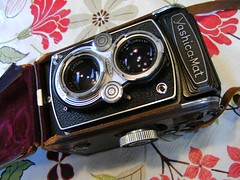
|
| 75mm Lumaxar, Copal MX image by Gerard Vogels (Image rights) |
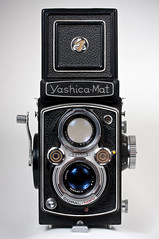
|
| 80mm Lumaxar (gold insert knob) image by Martin Taylor (Image rights) |
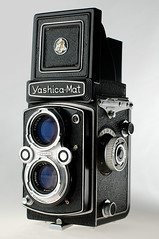
|
| 80mm Lumaxar (leather insert knob) image by Jeff Rawdon (Image rights) |

|
| 80mm Yashinon lens (black knob) image by Hans Marvell (Image rights) |
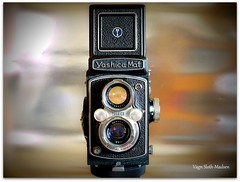
|
| 80mm Yashinon lens (silver knob) image by Vagn Sloth-Madsen (Image rights) |
The Yashica-Mat LM
The Yashica-Mat LM was introduced in 1958. "LM" stands for Light Meter, referring to the uncoupled selenium cell exposure meter in front of the viewfinder. It's an all-mechanical camera; even the light meter doesn't need a battery. The Yashica-Mat LM is a solidly made, easy-to-use camera.
|
|
| ||||||
| Yashicamat LM. Images by Dries van den Elzen. (Image rights) | ||||||||
Features
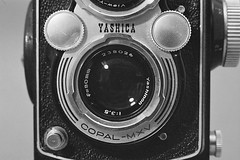
|
| image by Dries van den Elzen (Image rights) |
It has a Copal MXV central shutter with speeds from 1s to 1/500 and B. It offers flash sync at all speeds. The taking lens is a 3,5 Yashinon, an 80 mm four-element lens said to be of the Tessar design. It can be stopped down to F/22. The viewing lens is a 3,2 Yashinon. It accepts bay I filters. As in the earlier camera, the shutter speeds and diaphragm are set by two wheels on the front plate, and the values set are shown in a window above the viewing lens. Looking onto the ground glass in the waist-level finder, both values and light meter indications are visible.
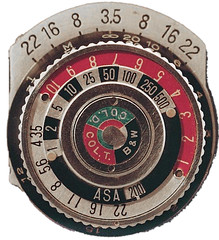
|
| image by Dries van den Elzen (Image rights) |
Focusing is done by a focusing wheel on the left of the camera. It has a distance scale surrounded by a depth of field scale engraved in the body.
There is a small window in which you can set the ISO value of the film you use and scales for LV, shutter speeds and diaphragms.
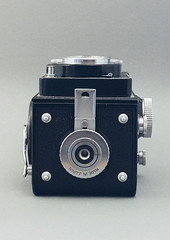
|
| image by Dries van den Elzen (Image rights) |
The body is all-metal, covered by black leather. It is quite a heavy camera, about 1.2 Kg. Film transport and cocking the shutter is done by a crank. Winding makes a rattling noise.
Its viewing hood contains a fresnel screen with red grid lines (5×5) to help composition. For exact focusing, it has a magnifying loupe.
The camera is loaded by opening the bottom: turn towards the "O" to open. It uses 120-rollfilm only, on which it takes 6×6 pictures (or more accurately: 55mm × 55mm)
The Yashica-Mat EM
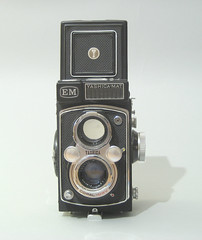
|
| image by Dries van den Elzen (Image rights) |
Released in 1964, the Yashica-Mat EM features an uncoupled light meter and an 80mm f/3.5 Yashinon shooting lens. The "EM" stands for Exposure Meter, referring to the uncoupled selenium cell exposure meter in front of the viewfinder. It's an all-mechanical camera; even the light meter doesn't need a battery. The Yashica-Mat EM is a solidly made, easy-to-use camera. It can be found for a reasonable price on eBay, and is an excellent introduction to medium-format photography. It's clearly an evolution in the line of the 1957 Yashica-Mat and the 1958 Yashica-Mat LM. It differs from the latter camera only in its easier-to-use exposure meter.
Features
It has a Copal MXV leaf shutter, capable of speeds ranging from B and 1 second to 1/500s. It offers flash sync at all speeds. The taking lens is a 3.5 Yashinon, an 80 mm four-element lens said to be of the Tessar design. It can be stopped down to F/22. The viewing lens is a 3.2 Yashinon. It accepts bay I filters. Shutter speeds and diaphragm are set by two wheels on the front plate, the values set are shown in a window above the viewing lens.
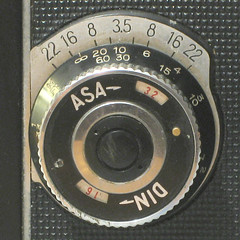
|
| image by Dries van den Elzen (Image rights) |
Focusing is done by a focusing wheel on the left of the camera. It has a distance scale surrounded by a depth of field scale engraved in the body. There is a small window in which you can set the ISO and DIN value of the film you use. ISO 400 is the highest value. The exposure meter is not coupled, so setting this speed is more a reminder than of any practical use.
The body is all-metal, covered by black square shaped leather. It is quite a heavy camera, about 1.2 Kg. Film transport and cocking the shutter is done by a crank. Winding makes a rattling noise. Looking onto the ground glass in the waist-level finder, the selected shutter speed, aperture and light meter indications are visible. Its viewing hood contains a fresnel screen with red grid lines (5×5) to help composition. For exact focusing, it has a magnifying loupe. The back plate of the waist level finder could be flipped open to expose the sports finder for additional composition possibilities.
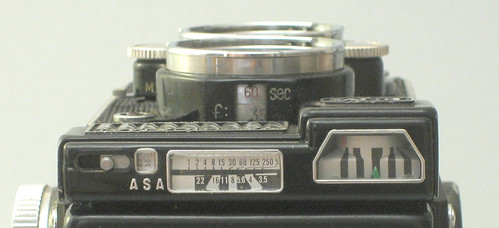
|
| image by Dries van den Elzen (Image rights) |
The camera is loaded by opening the bottom: turn towards the "O" to open. It uses 120-rollfilm only, on which it takes 6×6 pictures (or more accurately: 55mm × 55mm)
Images
Images by Dries van den Elzen. (Image rights)
The Yashica 12 and 24
|
|
Before the multi-format 124 model there were two separate metered models, the Yashica-12 (for 120 film) and the Yashica-24 (for 220 film). The word "Mat" did not appear in the model designations. Both shared characteristics of the later 124 and 124G, notably in the nameplate which contains the the meter as it has a round CdS meter cell in the front, along with ISO dial selection on the right. The left side of the body (by the nameplate) also has a cold accessory shoe. Copal SV shutter with speeds of 1-500 of a sec.
The Yashica 24 was introduced when the 220 film format became available circa 1965. The meter is activated by a Exposure Meter Switch button on the left-hand side of the body. Though designed for 220 film many Yashica 24's are compatible with 120 films. Later revisions of the cameras include supplemental instructions for using 120 film. It mentions shooting 5 extra exposures after the 12th exposure to end the shorter roll. It has markings for aligning the start marker on 120 films.
The Yashica-12 was based on the Yashica-24, it introduced a shutter lock and threaded cable release which was not on the Yashica-24. Metering no longer requires pressing a meter button, but is activated when the finder is raised.
The Yashica Mat-124 and Mat-124G
|
|
|
The Yashica Mat-124 is a camera made By Yashica until 1970. While it maintains many of the characteristics of the Yashica-24 and Yashica-12 it can choose between 12 and 24 exposures (thus 124) by changing the position of the film-pressure plate. The Yashica Mat-124 G is the succesor of the 124 and was made between 1970 and 1986 and was the last TLR produced by Yashica. Even if this type of camera seemed to be obsolete at the time of its appearance, the 124 series was a success.
Both models have a four-element, 80mm f/3.5 taking lens, of the better "Yashinon" variety. The Mat-124 and Mat-124 G (Yashica-12, 24) all accept Bay 1 accessories, such as those made for the Rolleiflex. Focusing is via a ground glass screen, with a 3x diopter loupe for critical focusing, as well as a sports finder. The focusing screen is used with the camera at waist-level. The sportsfinder, incorporated in the focusing hood, is operational by pushing the front cover backwards. According to the instruction booklet, it comes in handy for snapshots or when shooting fast-moving objects at eye-level. The Copal SV shutter features speeds 1 to 1/500 sec., plus B. It has a self-timer and flash sync with both electronic x and bulb m modes. They also have a coupled match-needle exposure meter, although it uses now-discontinued 1.3v mercury cells. Suitable air-zinc replacements and adapters for modern alkaline or silver oxide batteries may be obtained at camera stores and on the internet. They can handle both 120 and 220 film. The focus knob now has a film emulsion type reminder dial with settings for Day Reversal, Day Negative, Tungsten Reversal, B&W and Empty.
Since the camera is a Rolleiflex copy, the controls take a similar configuration. Build quality is very good. Yashicas are considered to be an excellent choice for entry-level medium format. The four-element 80mm f/3.5 Yashinon (taking) lens cannot be considered of equal quality compared to the Rollei’s, however it produces very good results, especially when stopped down to f/8-16. Unlike some Rolliflex models in sportfinder mode there is no additional mirror to reflect a portion of the screen to check focus in this set-up. An artificially inflated demand for the 124G has raised the price somewhat in the used market.
The 124 and 124 G are largely identical, save for trim the Mat-124 G was all black and electrical differences. The 124G pressure plate slides between 12-exposure and 24-exposure settings, while on the original 124 it pulls out and rotates. The covering on the 124 is the square pattern type while the 124G has changed to a more traditional pebble style leatherette covering.
The Yashica Mat-124 B is variation of the Mat-124G but without a exposure meter. The base of the camera has a locking knob with Brasil inscribed.
Links
General links
In English:
- Yashica TLR Cameras
- Yashica Mat-124G tribute page, by Berry de Bruijn (web archive version of a page that is now offline)
- Yashica Mat-124G at Aruku Camera (archived)
- Yashica Mat-124 at Classic Cameras by RaúlM.
- Yashica Mat-124g Review at Thorley Photographics by Neal Thorley (archived)
In English or French:
- Yashica Mat-124G in English and in French at Light in the Box / Lumières en Boîte, with downloadable user manual
In French:
- Yashica TLR overview, Yashica A and Yashica Mat-124G at Lionel's 35mm-compact.com
- Pages on Sylvain Halgand's www.collection-appareils.fr:
In Japanese:
Manuals and documentation
- Yashica leaflet (#72E1) dated 1972, featuring the Yashica-Mat and Yashica Mat-124G along with the Yashica-635 and Yashica-D knob advance models, at Goodharbor's flickr space
- Yashica Mat-124G assembling charts at Alan Corey's Yashica Old SLR page (version stored at web.archive.org of a website that is currently offline)
- Yashica TLR instruction manuals - PDF in Mike Butkus' Camera Manual Library
- Yashica repair manuals in Learn Camera Repair
- Manuals on David Richert's website (archived):
- Yashica D (jpg) (Wayback)
- Yashica Mat-124 (jpg) (Wayback)

